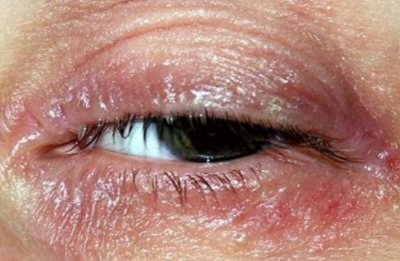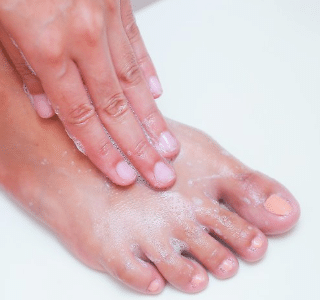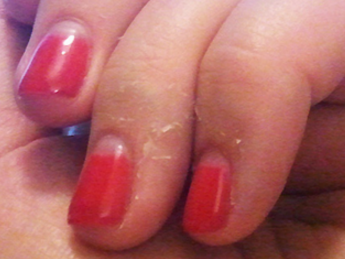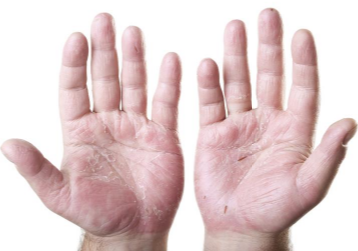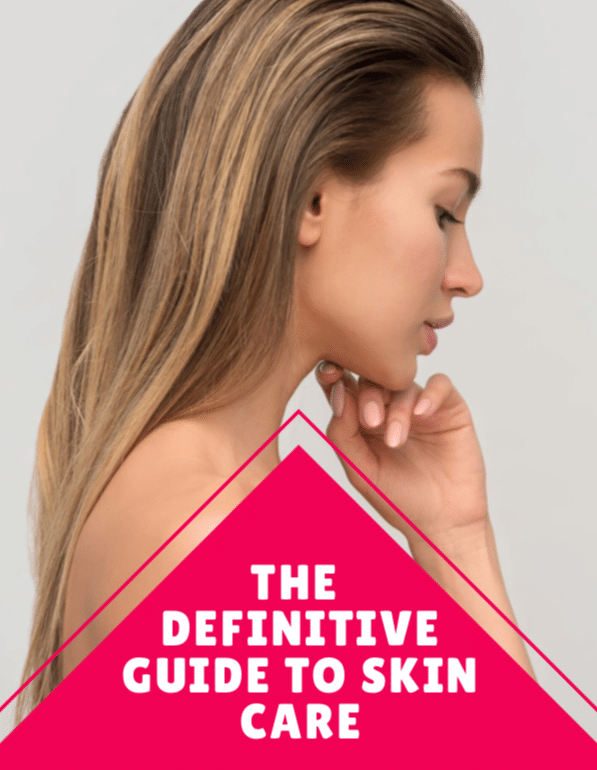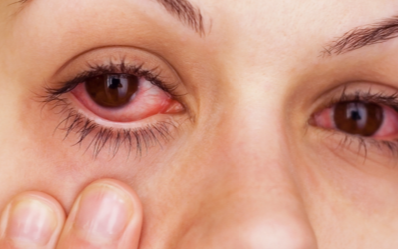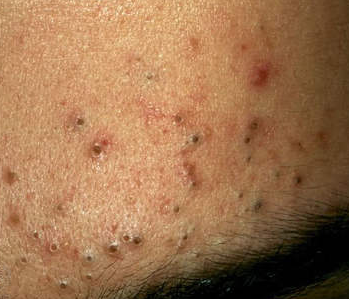Dry eyelids are a problem that affects numerous people, the dry, flaky skin can sometimes be embarrassing. Here’s how to treat dry skin on your eyelids.
Especially if you suffer from eczema or psoriasis. The dry skin on eyelid or flaky skin on your eyelids may be the worst of these problems, as it can be so much uncomfortable, irritating, and unattractive.
Before applying any medications to your eyelids to relieve the dryness, it is important that you talk to a skin doctor to find the underlying cause.
Your dry skin on eyelid could also be a sign of an underlying skin condition such as brephilatis.
Here, we are going learn about some of the symptoms, causes, and treatment methods for dry skin on your eyelids, and we will also discuss other skin conditions that can cause this problem.
Symptoms of Dry Skin on Eyelids
- Dryness
- Scales
- Itching
- Swelling
- Soreness
- Discoloration of skin
Dry Skin on Eyelid Causes
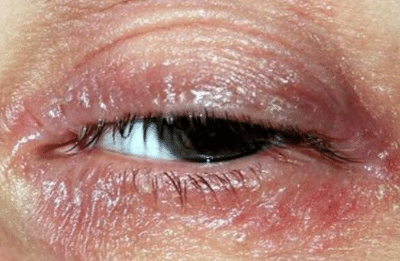
Dry Eyelids
Dry, flaky and scaly skin on your eyelids may be worrying conditions because it can be very uncomfortable, unattractive and irritating.
This problem may affect any person, usually those people who already have issues with the dry skin. Itchy eyes or very dry eyelids can be caused by different underlying issues.
Below are some of the main causes for your dry condition on eyelids. This may also include Sjogren’s syndrome. Other causes may include:
- Foods
- Shampoo
- Cleansers
- Psoriasis
- itchy
- Allergies
- Cosmetics
- Underlying Skin Conditions
- Eyelash Curlers
- Hair Dye-containing the ingredient
Causes of Dry Skin on Eyelids
In order to find an effective treatment, you have to first be aware of what is causing the dryness.
Some common causes are dermatological disorders such as the following:
-
Eczema on Eyelid
Can occur on the areas surrounding the eyes, including your skin on eyelids. To add on to dryness, this condition causes the skin to become scaly. When it is in more extreme cases, eczema on eyelid causes cracking, itching, reddening and swelling. If you don’t treat this condition, dry skin becomes inflamed and bleeding sets in. This increases the risk of infection and painful skin peeling, leading to blistering, oozing, skin reddening or discoloration of skin.
-
Blepharitis
Affects the eyelids, causing them to become inflamed with dry and scaly skin. This also causes a liquid substance to form on eyelashes, making hair clump together. Other symptoms to this problem include crusting, itching, and reddening. In more severe cases, this causes burning sensations, excessive watering of eyes, irritation of skin and eyes, mucus buildup, and oversensitivity to light. When it is ignored, this can cause decreased vision in one or both eyes.
-
Perioral Dermatitis
This is a serious and often chronic condition that is in most cases seen in adult women. It can as well spread to the nose and mouth areas in severe cases. The symptoms include bumpy rash, burning, itching, liquid or pus-filled bumps, reddening, and dry skin on eyelids. Research has revealed that products like lotions that contain corticosteroids, fluorine, paraffin, and petrolatum may trigger an allergic reaction that eventually is culprit to this condition.
-
Poor Hygiene
can result to bacterial, fungal or viral infection is also considered as a typical cause of this dry scaly skin on your eyelids.
-
Sunburn Injury
overexposure to the ultraviolet rays of the sun can lead to minor and serious burns to the skin. Other symptoms include dry skin on eyelid, blistering, dark pigmentation, fever, foul-smell of skin, heat stress, peeling, premature skin aging, reddening, retinal damage, skin cancer, stinging pain and suppression of the immune system. However, it also increases the risk of infection and inflammation.
-
Climate
The climate can damage in both hot and humid weather. Sudden changes or extremes in weather can aggravate the dryness of your skin. When temperature drops, air becomes drier due to low humidity. Less moisture in the air depletes skin of oil (sebum), which causes cracking, itchiness, reddening, and the appearance of fracture lines, which could split and bleed. This also causes skin to look dry, saggy and wrinkled. When the temperature rises, the risk of UV damage rises as well. This causes your skin to age prematurely. This slows down the skin’s inherent healing abilities, making the person highly susceptible to life-threatening conditions, like melanoma, neoplastic skin lesions and skin cancer.
-
Eye Skin Stress
this can also cause dry skin on eyelid. Excessive rubbing of the skin can result to stress. This is why dermatologists recommend against furious face scrubbing or constantly rubbing your face with dirty hands. It damages the epidermis, and compromises your vision as well. Eye skin stress can also be acquired from constantly washing your face with hot water. This may have grains of truth in it, but opening up your pores is not synonymous to freeing these from epidermal debris.
-
Harsh Chemicals
overusing facial cleansers and other skin products that contain harsh chemicals can result in dry skin on eyelid. The skin surrounding the eyes is thinner than the entire body skin, more sensitive, and naturally susceptible to irritations from chemicals and toxins.
-
Chronic Use or Abuse
this can permanently damage the epidermis, which does not only leave the skin dark and more prone to sun damage, but also increases its risk of bacterial, fungal and viral infection resulting to inflammation.
Read also: How to Get Rid of Dark Circles Under Your Eyes…
Red Burning Skin Around Eyes
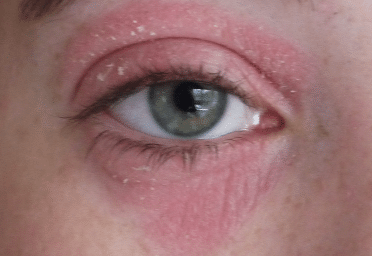
Red Burning Skin on Eyelids
Symptoms of ocular itching and burning are often normal.
The eye is susceptible to allergies and irritations due to the fact that it is a moist surface constantly in contact with the air, and all of its pollutants.
Furthermore, bacteria thrive on moist surfaces, and can cause substantial irritation as well.
Some of these bacteria related conditions can progress beyond simple itching, and can lead to a scratchy sensation or even pain.
Blepharitis is an infection or inflammation of the eyelids. It is an extremely common cause of ocular redness, itching, burning, and generalized irritation.
Other Symptoms
Include discharge (especially in the mornings), a scratchy sensation, tearing, and temporary blurred vision. The condition tends to involve both eyes.
It occurs when bacteria begin to excessively grow at the edge of the eyelid. The margin of the eyelid is a moist surface which is virtually always colonized by one strain of bacteria or another.
There are many substances that support the survival of bacteria in that location, including exfoliated skin and oil secretions.
People tend to avoid cleaning near the eye which allows material to build up at the base of the eyelashes, further aggravating this problem.
Bacteria at the edge of the lids create toxic by-products which irritate the eye, and the glands of the eyelids themselves can become infected and obstructed resulting to red burning dry skin on eyelids.
There are about 30 glands which open at the margin of each eyelid, and these are oil producing glands.
Some people have a dis-function of these glands where the secretion is abnormally thick and becomes trapped in the gland. This creates further irritation and can lead to sty formation.
People with the skin condition called acne rosacea tend to have blepharitis and dis-function of these oil glands.
Skin Around Eyes Burning and Swelling
If the area around your eyes is frequently inflamed, red or itchy, it’s important to get to the root cause of the irritation and find a treatment that works.
Puffy and itchy eyes are often the result of allergic reactions, the side effects of sleep medications, infections due to the use of expired makeup, hormonal changes or poor ocular health.
If over-the-counter medications do not alleviate the eye inflammation quickly, or your discomfort persists, you should see your doctor for an official and accurate diagnosis.
There are indoor and outdoor irritants that can affect the area around the eyes and cause eye allergies.
Examples of outdoor and airborne allergens may include: grass, tree and weed pollens.
Sensitivity to these seasonal allergens may produce allergic conjunctivitis, which is the most common type of eye allergy that results to dry skin on eyelids.
Common indoor allergens that may cause eye discomfort include molds, dust mites and pet hair or dander.
Prevention
You can prevent eyes burning and swelling by recognizing your triggers. If you have allergies, take note of days when your allergies will be highest.
Avoid visiting friends who have pets if they cause allergy. Carry hand sanitizer with you and use several times a day so that you don’t transfer germs and bacteria into your eyes especially after using public transportation or gym equipment or handling a grocery cart at the supermarket.
Read also: How to Remove Eye Bags Overnight…
Dry Burning Eyelids Treatment
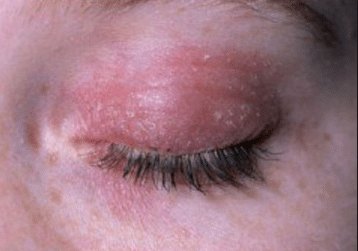
Dry Skin Around Eyes Treatment
If you are struggling with dry burning eyelids, your first step should be a trip to the eye doctor or dermatologist to make sure there is no underlying problem.
Although usually a minor issue, several medical conditions cause dry eyelids, including eczema, psoriasis, seborrheic dermatitis and blepharitis.
If no underlying medical condition is discovered, treatment consists of avoiding potential allergens and restoring eyelid moisture.
How to treat dry eyelids?
- Skin around your eyes is much more sensitive than skin around any other part of the body. If you just simply apply moisturizers or lotions then it could be quite unsafe. There are lots of creams and gels made by companies for the skin around your eyes and eyelids. If you use these types of lubricant then it can help you achieve the moisturized skin you are looking for on your eyelids. You can also try gently washing your eyelids with baby shampoo and then wipe the eyelid area and clean it.
- Avoid known allergies. Try to avoid some potential allergens like bacitracin ointment, facial cleansers, cosmetics, shampoos, nickel eyelash curlers and hair dyes that contain an ingredient. Do not continue using makeup until your dry skin on eyelids condition heals. Sometimes, fresh nail polish and some foods allergies can also affect your eyelids. Do not ever try to touch dirty surfaces with your hands because there are many people around us that naturally touch their face and eyes without even thinking for a second that it can harm their skin.
- Try to keep your hands clean by constantly washing them or by applying an antibacterial gel. Try to wash your face twice a day especially before reapplying makeup and before going to bed. Also, you can use warm pads and warm washcloths to soften the dry skin on eyelids that can make it easier to remove.
Dry Eyelids Home Remedies
Dry, peeling skin is a problem which many of us will face in the coming winter months.
But, if you’ve ever dealt with dry skin on eyelids, you know just how painful they can be.
So before we go into the prevention and treatment part let’s have a look at few common causes of this problem.
Dry skin around your eyes can lead to cracking, irritation, peeling, reddening, or skin discoloration.
Having chronic dry skin around the eyes also leads to permanent loss of dermal elasticity. This means that the skin doesn’t heal fast enough from superficial damage.
Fine lines eventually become deep furrows. These tend to radiate from your eyes, up to the base of the forehead and down to the cheeks and sides of your mouth.
External Remedies
According to skincare experts, the best treatment is to apply external remedies:
- Apply gentle strokes of moisturizer to the affected area. Make sure to use a light touch, as your eye skin is delicate and sensitive.
- Choose your moisturizer carefully, and avoid those that contain harsh chemicals. You can also make your own moisturizer to make sure that only natural ingredients go into it. Ingredients that work well to moisturize this area include almond oil, Aloe Vera gel, avocado oil, beeswax, buttermilk, coconut oil, egg yolk, frankincense oil, honey, lavender oil, myrrh oil, olive oil, sandalwood essential oil, Shea butter, sweet almond oil, vanilla oil, and Vitamin E.
You can use these ingredients individually or combine them to create your own DIY moisturizer.
-
Aloe Vera Rich Moisturizer
- Combine 4 tablespoons of organic aloe vera gel with 2 tablespoons of almond oil, and 2 tablespoons of melted extra virgin coconut oil (or homemade coconut butter) in a bowl. Pierce one Vitamin E capsule into the mix, optional. Apply lightly on skin around the eyes, and leave on for as long as possible. This recipe also works well for chapped lips and irritated dry skin on eyelids.
-
Frankincense and Myrrh Moisturizer
- Combine: ¼ cup of avocado oil, ¼ cup of melted coconut oil (or homemade coconut butter,) 1 tablespoon of melted beeswax, 10 drops frankincense essential oil, 10 drops of myrrh essential oil and 5 drops sandalwood essential oil in a bowl. Apply lightly all over the face, preferably at night. Leave on for as long as possible. This works well on sun-damaged skin.
-
Lavender Rich Moisturizer
Combine ½ cup of melted coconut oil (or homemade coconut butter) and 12 drops of lavender essential oil in a small bowl. Pierce one Vitamin E capsule into the mix. Apply lightly on skin around the eyes, and leave on for as long as possible. If desired, apply on the rest of the face and neck as well, preferably at night. This helps skin feel tighter.
- Note: Always buy therapeutic essential oils, or oils used for massages. Do not use aromatherapy or potpourri oils. Exceptions to this rule include almond oil, coconut oil, olive oil (which should always be food-grade), Shea butter (which is cosmetic-grade), and Vitamin E (which is a food supplement.
Natural Remedies
For skin injuries and disorders (eczema, perioral dermatitis, blepharitis, and injury from sunburn), try these natural remedies:
Eczema
Topical solutions like the application of organic avocado oil, coconut oil, and olive oil on the affected skin can help lessen visible signs of eczema.
Bathing in lukewarm water with sea salt, seat water, or Epsom salts also helps ease some symptoms of this condition of dry skin on eyelids.
If the eczema is rather severe, you can try bathing in lukewarm water with a good portion of fresh milk, or apply a salve made from uncooked old-fashioned oatmeal blitzed in the food processor with small amount of milk or water.
Eating foods rich in gelatin or probiotics might help, too. Probiotics will boost the good bacteria in your body to fight the bad bacteria and heal.
You may want to eat and/or apply plain yogurt topically or increase your intake of other foods rich in probiotics.
Perioral Dermatitis
If you have perioral dermatitis, avoid using scented soap and facial cleanser that can irritate your skin, especially around the eyes. Wash your face with nothing but warm water.
Take a break from wearing make-up, at least your eye make-up. Stop using face creams, including sunscreen in lotion form.
For mild cases of perioral dermatitis, place a couple of drops of apple cider vinegar in a cotton ball. Dab (not rub or soak) on affected area. Leave on for 5 to 10 minutes at a time. Wash with unscented soap.
Repeat step two to three times a day. Create a soothing salve by lightly applying plain or Greek yogurt of affected areas.
Leave on to dry until crusty. Wash with unscented soap. Repeat step at least once daily.
For more advanced cases, apply organic honey affected areas. Leave on to dry until crusty. Wash with unscented soap.
Repeat step at least once daily or when conditions flare-up.
1. Avocado and Lavender Oil Salve
Combine ¼ cup of avocado oil and 10 drops of lavender essential oils.
Apply lightly on affected area and leave on for as long as possible.
Apply at least once daily on dry skin on eyelids.
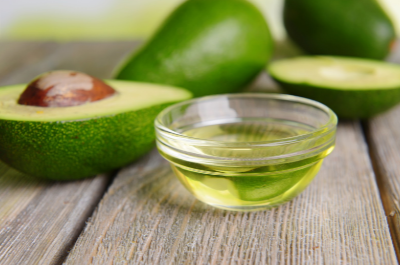
Avocado and Lavender Oil Salve
2. Shea Butter and Oregano Scrub
Combine ½ cup of Shea butter and 1 heaping tablespoon of dried oregano.
Apply gently on skin. Wipe away residue with clean paper towels. Repeat step at least twice daily.
3. Tea Tree Oil Salve
Combine ¼ cup of high quality olive oil with 12 drops of tea tree essential oil.
Eating anti-inflammatory rich foods will help ease some symptoms of perioral dermatitis, like: calendula flowers (use in salads or teas,) castor oil, coconut oil, green tea, honey, olive oil, oregano, Shea butter and turmeric root.
- Blepharitis: you can get rid of blepharitis naturally with lukewarm compress applied to your eyelids. Rinse and wipe gently using clean wash cloth or paper towel. To remove crusting, add a drop of baby shampoo (preferably with no-tears formula) in ¼ cup of water. Mix well. Place a small amount of mixture on a cotton ball and apply on affected area. Gently rub away crusts on eyelids and lashes. Rinse with clean water afterwards. Pat dry.
Castor oil and coconut oil (all applied topically) mixed with a couple of drops of calendula (marigold) essential oil or tea tree essential oil is all good natural remedies for blepharitis.
You can likewise benefit from a natural anti-inflammatory diet that includes ingredients like Brussels sprouts, chia seeds, eggs, flaxseeds, ginger, hemp seeds, soybeans, turmeric, walnuts, and food items rich in omega-3 fatty acids (e.g. anchovies, caviar, herring, mackerel, oysters, salmon, sardines, and tuna.)
- Sunburn:the best way to treat sunburn injury is to prevent the condition from happening in the first place. Avoid going out when the sun is emitting its hottest rays, or anywhere between 10 a.m.–4 p.m. Wear protective glasses and sunscreen with high SPF count when going outdoors.
If suffering from sunburn, try a cool bath or an oatmeal compress or apply milk or aloe vera. Other home remedies include:
4. Chamomile Facial Wash
Combine 2 cups of room temperature or lukewarm water, ¼ teaspoon of mild, unscented liquid facial soap and 12 drops of chamomile essential oil into a small basin.
Wash face with this solution using a clean face towel then rinse with plain water. Pat dry but do not scrub skin. Use this solution at least twice daily on dry skin on eyelids.
5. Honeyed Oatmeal Facial Mask
Combine 2 tablespoons of honey, 2 cups of warm water and 1 cup of old-fashioned rolled oats in a bowl.
Leave this to cool completely to room temperature. Apply to face (or affected area) and leave on for 20 to 30 minutes. Rinse well afterwards.
6. Strawberry and Yogurt Mask
Combine 1 cup of plain yogurt or Greek yogurt, and ½ cup of fresh strawberries, minced.
Apply to face (or affected area) and leave on for 10 to 15 minutes. Rinse well afterwards.
Further Reading: Healthline – Dry Eyelids

